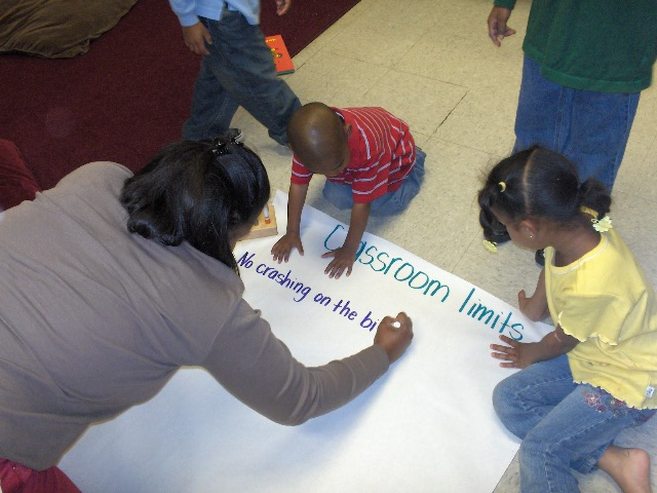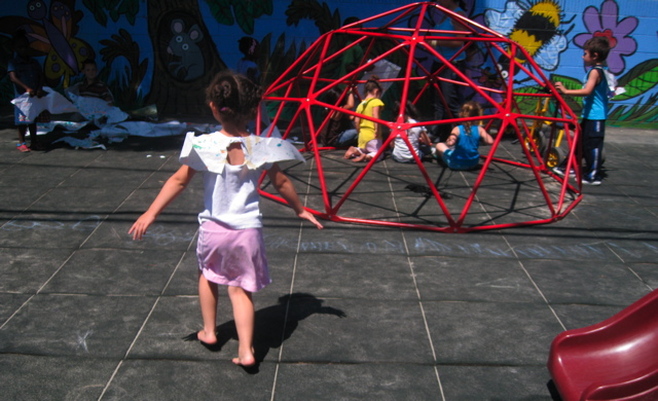 By Cheryl Ichikawa Children, even young children, understand fairness. At two years old they are developing a sense of autonomy, independence and freedom. The words, “No!” and “Mine!” have become their best friends. I watched a little boy walk around the classroom picking up items, content with just having them in his possession. He had a doll tucked under his arm, a baby bottle in one hand and a block (which he used as a phone) in another. He knelt down to pick up a bottle of bubbles, but in the process, his baby slipped from beneath his arm and fell to the ground. Another child was walking by, saw the baby on the ground, and picked it up. The little boy screamed and said, “No! No! No!... Mine!” as he lay on the ground in utter dismay. The child, startled by the outburst, handed the baby back to the little boy, who then quietly went about his business. What this boy was doing was using his voice and asserting his rights, as he saw them. As is typical for young children who are in nurturing and supportive environments, he has learned that his voice and actions give him influence in the world. What happens to many people as they grow, however, is that they lose that sense of influence. Whether it’s because they live in poverty and have scarce resources, or they don’t have a safe place to live, or they've experienced abuse or neglect…any number of factors can chip away at them until they are thoroughly disenfranchised. They learn that society is not always just. Social justice comes from a very specific place. It is born in the hearts and minds of individuals who want to make a difference in society. It’s about understanding the human condition and finding ways to address the needs of those people and families you encounter along the way. It’s about providing a little peace, harmony and support to mothers, fathers and children that deal with so much each and every day. It’s about letting people know that you see them for who they are and what they are trying to do with their lives and for their families. This desire to make a difference is what brought me to Children Today. What keeps me here are the children that greet me each morning with hugs and smiles. What I have learned about social justice is that what the compassionate side of our society is trying to accomplish is not simply giving things away, but providing a means by which people are allowed to find their own way. That is what we do at Children Today. Our parents allow us to care for their children so that they can find a way to be self-reliant, responsible, and productive members of their community. They want to be seen. They want to be understood. But most importantly, they want to be valued for who they are and what they are trying to accomplish in their life. For many, that is being able to take care of their family, and isn’t that what most of us are trying to accomplish?  By Dora Jacildo Growing up, I was very fortunate to be surrounded by many people who helped me develop a sense of what social justice means. I had teachers who taught me the value of taking turns to ensure that everyone had a chance to participate meaningfully, a mother that was concerned with making sure that my sisters and I learned about fairness, classmates who advocated on my behalf when I didn't know how to speak English and was too emotionally overwhelmed to stand up for myself, and a community that believed that living in harmony benefitted us all. The Center for Nonviolence and Social Justice states that "Social justice embodies the vision of a society that is equitable and in which all members are physically and psychologically safe. Social justice also demands that all people have a right to basic human dignity and to have their basic economic needs met." Throughout my life, I have had the privilege of working alongside people who have truly embraced the principles of social justice and made it their mission to work towards the development of stable, safe, and just societies. Children Today's founders, board members, staff and supporters have all contributed to making it a social justice agency with a successful track record of addressing poverty, violence, trauma, oppression, racism, and other issues that have marginalized families. I am so proud of the work that we do in responding to families' immediate needs, advocating for long term systems changes, and teaching the young children we serve about social justice by being a living example. Children understand fairness, they understand empathy, they know about dignity and respect. The children we serve are a lot like the child I used to be and, perhaps, because of the experience they are having in our programs today, they may choose to be the ones to continue the pursuit of social justice and working towards ensuring that all of our members achieve self-actualization and self-determination. Editor's note: The United Nations has declared February 20th as World Day of Social Justice. To learn more, visit their website.
By Elia Rocha I think we can all agree that no child should go hungry and that every child is entitled to healthy, nutritious food. The prevalence of food insecurity in the United States, especially amongst children, is scandalously high. It is also well-worn territory, so I won’t go into it here – although if you do want to learn more about the consequences of child hunger and food insecurity, I encourage you to visit No Kid Hungry. What I do want to share is what food insecurity looks like from our vantage point, here at The Play House programs. Like most child development facilities serving low-income households, we offer fully subsidized meals and snacks. We follow USDA guidelines to ensure that we are providing plentiful, balanced, and nutritious foods. And yet, what we sometimes see when we serve meals is anxious monitoring of how much is there, who’s getting what, and will there be enough for me? Obviously, every child has a unique history and disposition, and reacts to challenges in their own way. A while back, the preschool classroom at the Play House North had a particular mix of histories, dispositions, and reactions which bounced off each other to create real turmoil at meal times. We had some children who seemingly could not be sated, one child who hid food, and another who was so anxious that he wouldn't get enough to eat that he needed to lie down before meals to try to calm himself. For teachers, the children’s reactions triggered their own anxieties. After all, what is more primal for a caregiver than feeding their charges, and what can feel worse than not satisfying a child’s hunger? Naturally, the whole classroom felt the tension and reacted in kind. Now, we’d had occasional acute worries around food before, but never in this concentration and to this degree. It was a difficult situation, one that prompted a fundamental change in how we dealt with meals. What we did was limit food. I don’t mean to imply that we had an inexhaustible supply before. No, we had portion recommendations for each meal, but we always made more than was strictly needed for parents who wanted to share meals with their kids, or for families who wanted to take leftovers with them at the end of the day. And, since we served our meals family style, the idea was that kids would help themselves from communal bowls. We decided to set up a structure; two servings per child of the main menu item. Only that amount of food was presented at the table and the rest was stored elsewhere. It may seem counter-intuitive, even ungenerous to restrict food in this way. The key is to understand that by presenting an over abundance of food we weren't satisfying children’s hunger, but instead were feeding into their anxieties. Setting up the two-serving structure and keeping the rest of the food out of sight relieved children of the burden of responsibility over how much they were going to get, and from feeling the need to compete. The structure also introduced much more predictability around meal times. Teachers could reassure children that the same thing would happen every day; each child could have two servings if they wished, each child would have access to the same quantity of food, and there would always be enough for everyone. For children with a history of trauma, establishing a predictable environment is critical to their sense of safety and security. Meal times are clearly no exception, so this new structure made a big difference. Everyone has a personal relationship to food, which starts literally from day one. Those who have experienced food insecurity and privation know that even when they have enough to eat, fears about food can still feel like an existential threat. It is not surprising then, that these same fears cause some of our little ones to react the way they do. Even when there is enough, when it is plainly there before them, they’re still swinging.
By Elia Rocha Some years back, two new scooters were stolen from the shed in the preschool yard at the Play House West. Teachers shared the bad news with the kids and each child got the chance to talk about how the theft made them feel. Teachers wrote down their thoughts and stapled them onto the shed. Talking about what happened and writing down their feelings gave the preschoolers an opportunity to take some power back from the theft. Children said things like, “You made everybody sad at my school," and "Please, please get out of our yard. Stay in your yard and get your own stuff." While it is certainly a caregiver's job to protect children, when something bad does happen, it is just as important to acknowledge it and provide kids with a safe space to explore and process their feelings. For our children, who have had more than their fair share of bad things happen, it is all the more important to help them build the resiliency (the ability to bounce back) that they, and all kids, need.
When I saw the preschoolers' words stapled onto the shed, I remember thinking how powerful a message they were. They said, "We're here, this happened to us, we're a community, and we have a voice." |
AuthorVarious members of the Children Today staff contribute to these blog posts. Archives
July 2024
Categories |
